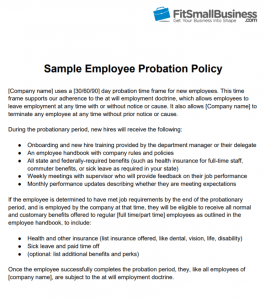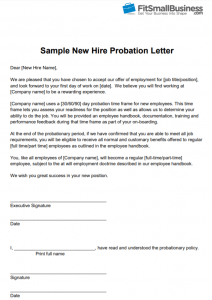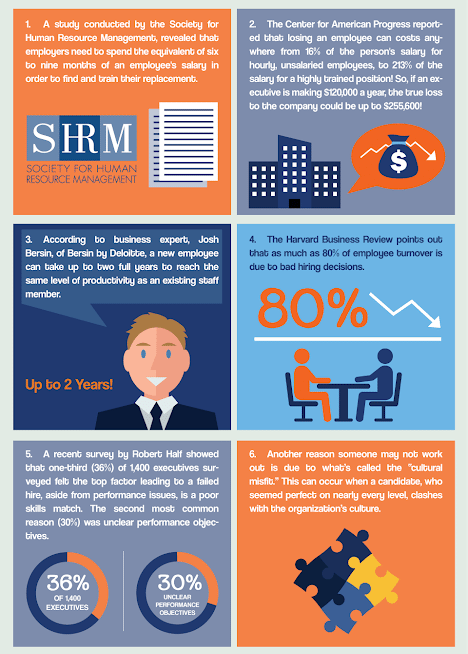A employment probation period, referred to as a predetermined interval, is a time frame used to determine if or not a new hire will work out. A probationary period may be risky if setup wrongly, as it may violate local labor laws or undermine employer rights. Thus, we will provide best practices for setting up an employment probation period.
An optional occupation probation period, generally a part of onboarding new hires, gives both you and your new team member the chance to make sure the job is a great fit. Very similar to at will work, there is no requirement for the new hire to stay if the job does not feel like a good fit for them, nor to the employer to maintain a worker who doesn’t fulfill job expectations.
In reality, an employer might consider withholding some advantages and perks until after the probation period is over and they know that the employee is able to execute the job for their standards. However, a few countries, such as California and New York, have mandatory sick leave laws. And companies with over 50 full-time employees are required to provide health insurance; thus be careful if you choose to postpone sick leave or health benefits until after the probation period. It could be illegal in some instances.
Disclaimer: since there’s a potential risk of an employment statute period undermining an employer’s”at will” employment status, or clauses inside violating local statutes, please seek the help of a labour law attorney familiar with both state and federal law prior to executing a new hire employee probation program.
Sample Probation Period Coverage
 Here is a free sample probation policy document template that you can download and customize to your business’ needs.
Here is a free sample probation policy document template that you can download and customize to your business’ needs.
Please note that SHRM suggests altering the phrase”probationary period” into”trial period,” and supplies the specific wording below to Prevent any conflict with the will employment doctrine:
“Completion of this trial period does not induce you to stay employed by the company for any definite time period. Both you and the business will be free, at any time, without notice and with or without cause, to finish the employment relationship. After completion of this trial period, eligible employees will receive the benefits described in this handbook.”
- Download Sample Probation Policy as PDF or DOC
Sample New Hire Probation Period Letter
 To make sure there is no mistake with new hires regarding your probation coverage and time frame for your probation period, think about taking the additional step of crafting a probation policy letter, such as the one revealed.
To make sure there is no mistake with new hires regarding your probation coverage and time frame for your probation period, think about taking the additional step of crafting a probation policy letter, such as the one revealed.
From the letter, reiterate your probation policy and think about asking the worker to see, sign, date and return a copy of the letter on their first day of employment.
A letter signed by the worker may offer evidence that the employee was fully aware of the probation policy in case of a wrongful termination lawsuit.
- Download Sample New Hire Probation Period Letter as PDF or DOC
How to Implement an Employment Probation Period
To execute a probation period, you are going to want to begin using a few conclusions, like the time frame and what additional training or service will be provided during the probationary period. You also need to ascertain what benefits the employee will receive upon hire versus what benefits will wait till after the job probation period is over.
Then draft and discuss your employment probationary policy before implementing this, using these steps:
9 Steps to Implementing a Probationary Policy
- Determine time period — 30, 60, or 90 days are the most usual.
- Pick on your rules — Can you permit employees to start some advantages today and wait until after they complete probation for some other benefits? What happens if they call in sick during their probationary period of time? Are they supplied onboarding? Training? Feedback? When and how frequently?
- Create your policy — Document your coverage using our template as a starting point.
- Get attorney comments — Have your policy reviewed by a legal specialist to make sure it doesn’t violate any state or local requirements to provide benefits to new hires.
- Stressing the new policy to employees — Share the new policy and expectations together with present employees, like providing instruction, tools, and opinions to new hires.
- Update employee handbook — Insert your policy to your current employee handbook.
- Include it in most new hire documentation — make sure that your job ads, interviews, and project offer letter explain the new hire will be subject to a probationary period.
- Formalize your new hire probation period — Send a letter to the new hire.
- Plan to evaluate employee performance at regular intervals — Once an employee is hired under the new app, make certain that you’re giving them good employee performance feedback so they know your expectations and can proactively address problems.
Factors for Using an Employment Probation Period
In addition to providing instruction and ensuring that you do not violate any labour laws, take a look at some benefits and drawbacks before you formalize an employment probation period in your small business. While turnover is pricey, hiring the wrong employee can be more costly.
That’s where using an employment probation coverage can help weed out candidates before they’re on your deductions forever. Another means to reduce turnover is to put money into training for all new hires, particularly during their first few months — whether you refer to that time as probation or not. Have a look at these shocking statistics from Quantum Workplace.

Turnover statistics infographic from quantumworkplace.com
Employment Probation Period Time Frame
SHRM indicates the most typical time frame for a new hire probation period, or introductory period, is 60 to 90 days. However, you, as the employer, can place any time frame you want to fully evaluate whether a worker matches your culture and can do the job. Here are examples of when each of the subsequent 30/60/90-day time frames makes sense.
30 Days
Thirty days is a fantastic time frame to get a job probation period in an entry level job, such as food service or retail, where you are going to know quite quickly if the employee is going to work out. For instance, if an employee can show up on time, display a positive demeanor, gets along with co-workers and may master your POS systems, they will likely demonstrate those traits (or not) inside the first few weeks.
60 Days
Sixty days is a fantastic time frame to use as a probationary period in tasks with productivity metrics. By way of example, if you hire workers who must master skills like building furniture, entering data, stocking shelves, or inspecting manufactured goods, you’ll want time for those employees to learn the occupation. After they master the skills, you will want additional time to evaluate whether they’re in a position to meet your hourly or daily productivity objectives.
90 Days
Ninety days is a good time frame to use for new hires in professional functions, like managers or sales executives. The main reason for the longer time period is that you may choose to see how they work in the job, as well as whether they are able to create relationships, earn business or motivate their staff. Since 40% of leaders fail within the first year, it can be best to cut your losses early in the event that you don’t see exactly what you anticipate within the first 90 days.
What HR Professionals Say About Employment Probation Period Time Frames
A question was posed to HR professionals on SHRM’s HR website to find out whether they use probation periods and time frame was the most frequent. The majority of those who responded felt 90 times was the most common, but added they believed probationary periods to become obsolete and best utilized in marriage and government environments, not small business.
1 HR director respondent out of Puerto Rico, a territory that doesn’t admit at will employment, says many companies there use a probation period. Another anonymous HR blogger summed it up best:
Anonymous Quote on SHRM HR Blog
“We have a 90-day introductory period. Our handbook notes ‘successful completion of introductory period does not change the at will employment position.’ Frankly, it’s obsolete, but [it is ] our clinic. Really [it] just impacts a number of our benefits — can’t use PTO time in intro interval, employee discount qualified after intro period, etc.. We do have a casual review at 90 days as well as reevaluate wages.”
Employment Probation Period Guidelines
There are guidelines to consider when selecting to utilize a predetermined period of time, like ensuring it doesn’t violate any labor or employment legislation at the state or federal level. Three examples are provided below to illustrate why it is very important to work with an attorney or HR consultant before implementing your policy.
Example 1: Mandatory Health Insurance
If you’ve over 50 full-time employees, you must offer health insurance to your employees. Most health insurance companies need this to be offered within the first 30 days. For this reason, you can’t withhold health insurance until after the employee completes a 90-day custody period. However, you can wait to provide 401(k), dental, life insurance, or other perks before after the probationary period is over.
Example 2: State and Local Regulations
California requires employers to pay workers for up to three days of sick leave each year. New York and other states have similar laws. Some cities also have particular regulations; for instance, if you employ more than 10 people in San Francisco, then you are required to provide 72 hours of sick leave annually to fulltime employees. In any case, you can not wait and just provide sick leave after childbirth is over. It might need to start accruing upon hire, or be supplied as a lump sum.
Example 3: Anti-discrimination Legislation
Laws like ADA and Title VII protect employees from day one, so be sure your motive for terminating a worker, even during a probationary period, is non-discriminatory and legally sound.
Advantages of Implementing a Employment Probation Period
Some companies feel that utilizing an employment probation period reduces their hiring risk. It may be true in the sense that workers who don’t mean to carry out well may choose not to accept work in a business with an employment statute period. Additionally, an employer may feel there is less danger in firing someone within their probation period. Other advantages may include:
- Allows a brand new hire to determine whether the job is a match, providing them an easy out if it does not
- Lets the company terminate an employee”guilt-free” during their probation period
- Avoids companies paying for expensive perks until worker is proven
Terminations nationwide are down within the past 18 years according to the Bureau of Labor Statistics, as revealed in the graph below, where the average turnover rate for workers who have been employed for one year is hovering between 3.5 and 4 percent. If your conclusion rate is higher, you may think about if or not a trial or probation period will help by weeding out less qualified candidates ahead of time, or whether you need to do a better job sourcing applicants.

Downsides of Enforcing an Employment Probation Period
There are a number of downsides to some formal employment probation period (which many HR specialists consider is unnecessary in countries that currently allow for employment at will). For example, courts can interpret your probation period to indicate that after it’s over, employees can only be terminated for cause. Some other downsides include:
- Employee may feel eligible after custody period is over — you may Wind up needing to handle employee subject issues
- Setting up an employee probation period may violate labour law in countries like Montana or territories like Puerto Rico that do not honor will employment — verify your state’s labor laws
- Documentation must be rock-solid — not only should you record your policy to protect yourself, but ensure that all workers, and especially new hires, are made aware of the employment probation period coverage
SHRM provides additional information on dangers of using a predetermined interval. We also asked employment law attorney Kimberlee Gee, Esq., to share her ideas:
“Using a’probationary period’ can create an implied agreement that the patient must be employed for a definite period of time. Basically, even if your business is within an at-will employment condition or you have an employment arrangement informing the employee he or she is designated an’at-will worker,’ you run the risk of confusing the employee regarding their status and endangering any lawful defenses or protections your business might have otherwise needed should a wrongful termination suit arise.
This can happen in two ways:
1) The worker may consider that the probationary period provides the employee a certain period of time to meet certain job expectations or performance criteria, and that he or she Cannot Be terminated during this time; or
2) The worker will believe that after they’pass’ the probationary time they have some right to continued employment and they can’t be dismissed without cause. In effect, they believe they have some due process right that the employer never intended to convey.
My opinion is that from a legal defense perspective, if your business is in an at-will employment authority or you experience an employment agreement in place properly designating the employee as an at-will employee, the probationary period is not required, as the designations could be viewed as being at odds with one another.”
— Kimberlee Gee, Esq., Founder, Kimberlee Gee Legal
The Most Important Thing
When some employers like having a new hire employment probation period, it may not be required if your state permits the employment at will doctrine. You may already have the right to terminate an employee without cause, as long as no anti-discrimination or labour laws are broken. In the event you decide to institute a probationary period, consider using our template, and having your attorney review your probation period policy prior to implementing it.
LawTrades supplies low cost legal services and can help you to find an attorney to advise you on dangers to avoid when establishing an employment probation coverage on your industry and location.
See LawTrades

